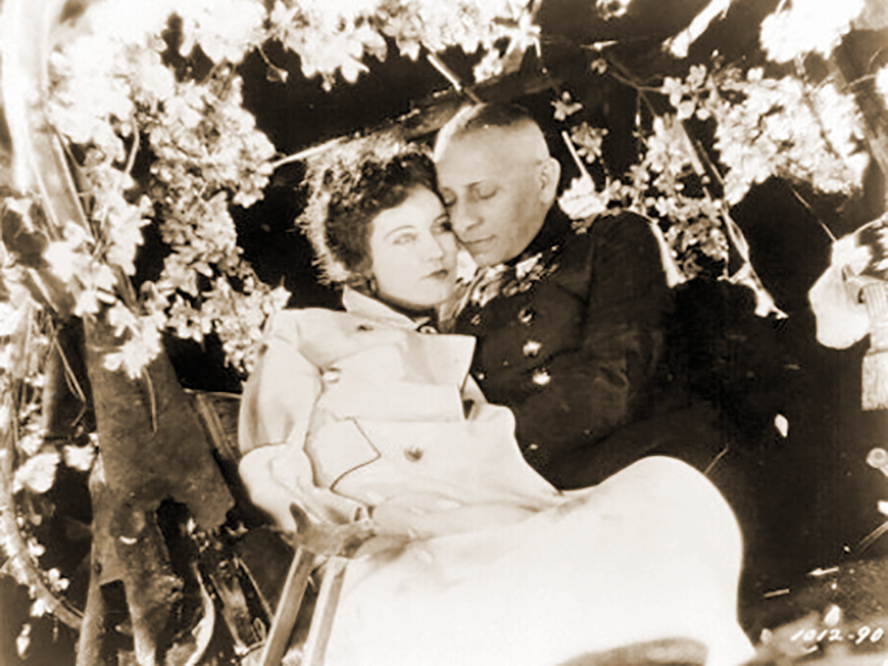| |
 |
| |
Fay Wray and Erich von Stroheim.
Photograph: Silent Era image collection.
|
The Wedding March
Also known as Symphonie Nuptiale and Mariage de Prince in France: [La marcha nupcial]
(1928) United States of America
Color/B&W : 11 reels / 10,721 feet / 113 minutes
Directed by Erich von Stroheim
Cast: Erich von Stroheim [Prince Nicholas Ehrhart Hans Karl Maria von Wildeliebe-Rauffenburg], Fay Wray [Mitzerl Schrammell], ZaSu Pitts [Cecilia Schweisser], Mathew Betz [Johann Adelbert ‘Schani’ Eberle, Mitzi’s fiancé], George Fawcett [Prince Ottokar Ladislaus von Wildeliebe-Rauffenburg], Maude George [Princess Maria Immaculata von Wildeliebe-Rauffenburg], Cesare Gravina [Martin Schrammell, violinist at the beergarten and Mitzi’s father], Dale Fuller [Katerina Schrammell, his wife and Mitzi’s mother], George Nicholls [Fortunat Schweisser, the corn-plaster magnate and Cecilia’s father], Hughie Mack [Anton Eberle, the beergarten owner and Schani’s father]; Sidney Bracy [Navratil, Nicki’s valet], Anton Vaverka [Emperor Franz-Josef], Don Ryan [H.I.H. Archduke Leopold Salvator], Lucille van Lent [Prince Nicki’s maid], Danny Hoy [?] (Arthur Lubin)? [mountain guide idiot], Captain John S. Peters [Imperial Guard officer], Carey Harrison [Imperial Guard officer], Harry Reinhardt [Imperial Guard officer], Count Albert Conti [Imperial Guard officer], Wilhelm von Brincken [Imperial Guard officer], Schumann-Heink [Imperial Guard officer], von Hartmann [Imperial Guard officer], Ray Erlenborn [altar boy], Claire Delmar, Lurie Weiss [Cecilia’s maid (role cut from final film)]
[?] Celebrity Pictures and/or Paramount Famous Lasky Corporation? production; distributed by Paramount Pictures Corporation. / Produced by [?] Pat A. Powers and/or Erich von Stroheim? Scenario by Erich von Stroheim and Harry Carr. Art direction by Richard Day + [Erich von Stroheim]. Special military assistants, Count Albert Conti and D.R.O. Hatswell, R.N. Technical consultant, Archduke Leopold of Hapsburg. Assistant directors, Eddy Sowders and Louis Germonprez. Second assistant directors, Eddie Malone and Art Jell. Cinematography by Hal Mohr + [B. Sorenson]. Edited by Frank E. Hull + [Josef von Sternberg]. Original music score by J.S. Zamecnik + [Louis de Francesco]. Musical arrangements by John M. Leipold and Victor Young. Presented by Adolph Zukor and Jesse L. Lasky, by arrangement with P.A. Powers. / © 8 October 1928 (at 14 reels) by Paramount Famous Lasky Corporation [LP25696]. Premiered 6 October 1928 at the Rivoli Theatre in New York, New York. / Movietone 35mm spherical 1.20:1 format (sound version) and Standard 35mm spherical 1.33:1 format (silent version). Corpus Christi procession sequence in Technicolor No. 2 two-strip color process sequence. Western Electric Movietone sound-on-film synchronized sound system. / Originally budgeted at $750,000, Stroheim maintained that the production costs of the total film as shot was $900,000; producer P.A. Powers stated that the costs ran to $1,125,000. With approximately 200,000 feet of negative filmstock exposed, Powers halted production with approximately two-thirds of the second half of the film shot. Stroheim’s first rough cut was approximately 50,000 feet, or about 50 reels, running about eleven hours. Originally cut as a two-part film; the first part was titled The Wedding March and Frank Hull’s first cut, made under the supervision of Stroheim, was 25,795 feet. A second editing of the first part, imposed by Paramount, resulted in a version of 17,993 feet, which was (according to Josef von Sternberg) approved by Stroheim. Julian Johnston edited a third version to 11,147 feet, and Stroheim, assisted by Sternberg, edited a fourth to 11,062 feet. Stroheim and Sternberg edited the final release version, the fifth cut, to 10,400 feet, which was released in 14 reels accompanied by 14 synchronized sound discs of orchestral music accompaniment. The second part of the film was to be entitled The Honeymoon, and was first edited by Stroheim to 22,484 feet. A second version was edited by Sternberg to 10,789 feet. Paramount editors further reduced part two to approximately 7000 feet — 2000 feet of which recapped the story of the first part to make a more coherant film. The second part was filed for copyright at approximately 6000 feet. Part two originally appeared only in European prints, released as Mariage de Prince in 1929 in France. The legend “The Man You Love to Hate” appears (perhaps for the first time) in promotional materials for The Wedding March. The film is reputed to have been distributed to theatres for both a sound-on-disc system (1.33:1 format) and the Movietone sound-on-film system (1.20:1 format). The film was also released in the USA in a silent version (at 10,659 feet) by Paramount Pictures Corporation. Portions of the existing preservation print appear to have survived only as a 16mm reduction print. In 1950, Von Stroheim was reputedly invited by Henri Langlois of La Cinémathèque française to reedit The Wedding March and The Honeymoon from prints the archive held; reputedly, Von Stroheim combined the two films, added sound effects (to the existing Zamecnik soundtrack?), and restored his original sequencing. It is not known whether this version was ever circulated and it may have been destroyed in the 1959 La Cinémathèque française fire. / Silent film, with synchronized music and sound effects.
Drama: Romance.
Synopsis: Synopsis available in Weinberg-Stroheim pp. 179, 182-185.
Survival status: Print exists in the Library of Congress film archive; the second part of the film, The Honeymoon, is presumed lost.
Current rights holder: Public domain [USA].
Keywords: Animals: Horses - Austria: Vienna - Color cinematography - People: Emperor Francis Joseph I of Austria (1830-1916) - Synchronized sound film - Weddings
Listing updated: 25 April 2025.
References: Film credits, film viewing : Bardèche-History p. 289; Basten-Technicolor p. 170; Bohn-Light p. 87; Brownlow-Parade pp. 244, 245, 266; Everson-American pp. 13, 286, 288, 289-290, 310r; Fell-History pp. 114, 115, 116, 125; Geduld-Birth p. 39; Higashi-Virgins p. 147; Maltin-Classic p. 767; Quirk-Swanson p. 213; Sarris-Sternberg pp. 16, 24; Shipman-Cinema p. 98; Sinyard-Silent p. 126; Thompson-Lost p. xviii; Weinberg-Wedding p. ?; Weinberg-Stroheim pp. ix-x, xii, xiii, xiv, xvi, 6, 176-208, 257 : ClasIm-305 p. ? : Website-AFI; Website-Wikipedia.
Home video: VHS.
|




































